The best 3D printers of 2025, like the Anycubic Kobra S1 and Flashforge Adventurer 5 Pro, deliver high-speed printing and advanced features perfect for professionals and creators. Models such as the Bambu Lab A1 Mini excel in multi-color printing and portability, while the Creality K2 Plus Combo offers a large build volume and dual-camera monitoring. Whether you’re looking for speed, material versatility, or user-friendly setup, these top picks provide cutting-edge technology for every need. Explore our expert reviews to uncover the perfect printer for your projects.
Key Takeaways
- High-speed printers like Anycubic Kobra S1 and Creality K2 Plus offer rapid printing with accelerations up to 20,000 mm/s².
- Printers support diverse materials, including composites and multi-color options, enhancing versatility for various projects.
- User-friendly features such as quick setup, auto-leveling, and app monitoring simplify the printing process for all users.
- Advanced capabilities like multi-color printing and specialized structures (Core XY) cater to professional and intricate printing needs.
- Large build volumes and durable components in models like Creality K2 Plus accommodate professional applications and extensive projects.
FLASHFORGE Adventurer 5 Pro 3D Printer
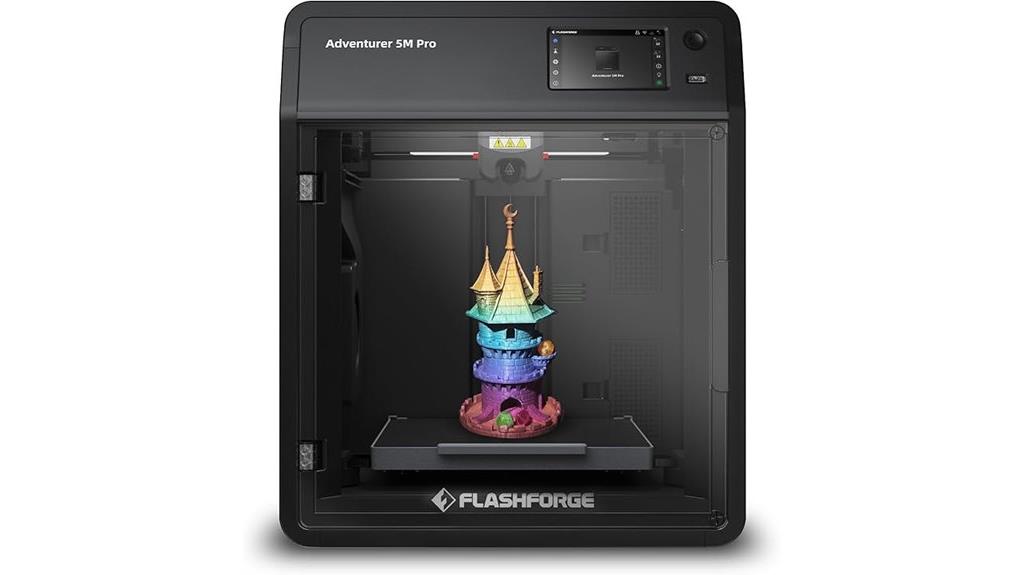
This printer supports a wide range of materials, including PLA, ABS, and TPU, thanks to its robust full-metal extruder. Setup takes just 10 minutes, and the Flash Maker app lets you monitor prints remotely. Add features like auto-shutdown and filament detection, and you’ve got a versatile, user-friendly option for both prototypes and durable components.
Best For: Hobbyists, educators, and small businesses looking for a versatile 3D printer that supports a wide range of materials and offers user-friendly features.
Pros:
- Supports multiple materials, including PLA, ABS, TPU, and composite filaments, making it suitable for both prototypes and durable components.
- Quick setup time of 10 minutes and smart automatic bed leveling ensure ease of use for beginners.
- Features like remote monitoring via the Flash Maker app, auto-shutdown, and filament detection enhance convenience and workflow efficiency.
Cons:
- The all-metal frame, while durable, may contribute to a heavier machine and potential operational noise.
- No information on ultra-high-temperature material support, limiting compatibility with advanced filaments like PEEK.
- The build volume, while sufficient for most projects, may be a limitation for users requiring larger prints.
https://www.amazon.com/dp/B0CH4RG161
Anycubic Kobra S1 3D Printer
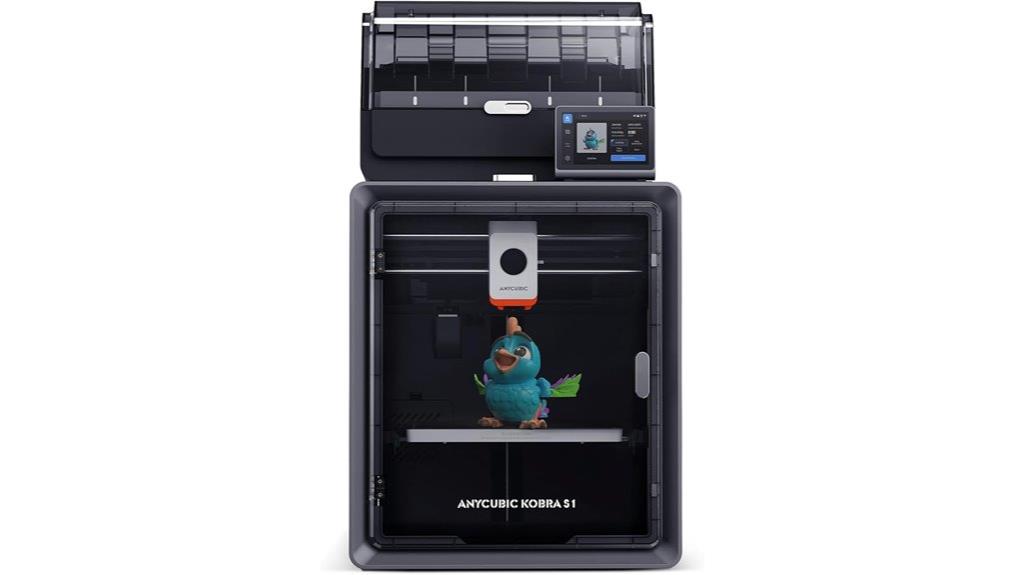
Printing at an impressive 600mm/s, the Anycobic Kobra S1 3D Printer is ideal for professionals and hobbyists seeking high-speed, efficient 3D printing. You’ll appreciate its multi-color printing, supporting up to 4 colors, or 8 when paired with two ACE PROs. The built-in drying function streamlines workflows by eliminating the need for an external dryer. With acceleration up to 20,000 mm/s², it prints 12x faster than standard FDM printers. Flow correction technology certify smooth surfaces and reduces waste. Remote control via the Anycubic App offers one-click printing convenience, while multi-plate document parsing handles complex tasks. A versatile, high-performance tool for any workshop or studio.
Best For: Best For: Professionals and serious hobbyists seeking high-speed, multi-color 3D printing with advanced workflow features.
Pros:
- High-speed printing with a max speed of 600mm/s and 20,000 mm/s² acceleration for 12x faster production.
- Supports 4-color printing, expandable to 8-color with two ACE PRO combinations.
- Built-in drying function eliminates the need for an external dryer, streamlining the process.
Cons:
- Potentially higher cost due to advanced features and multi-color capabilities.
- May be overly complex for beginners due to its advanced features and multi-color setup.
- Built-in drying function could add to the machine’s noise and energy consumption.
https://www.amazon.com/dp/B0F8B68NF3
FLASHFORGE Adventurer 5M Pro 3D Printer
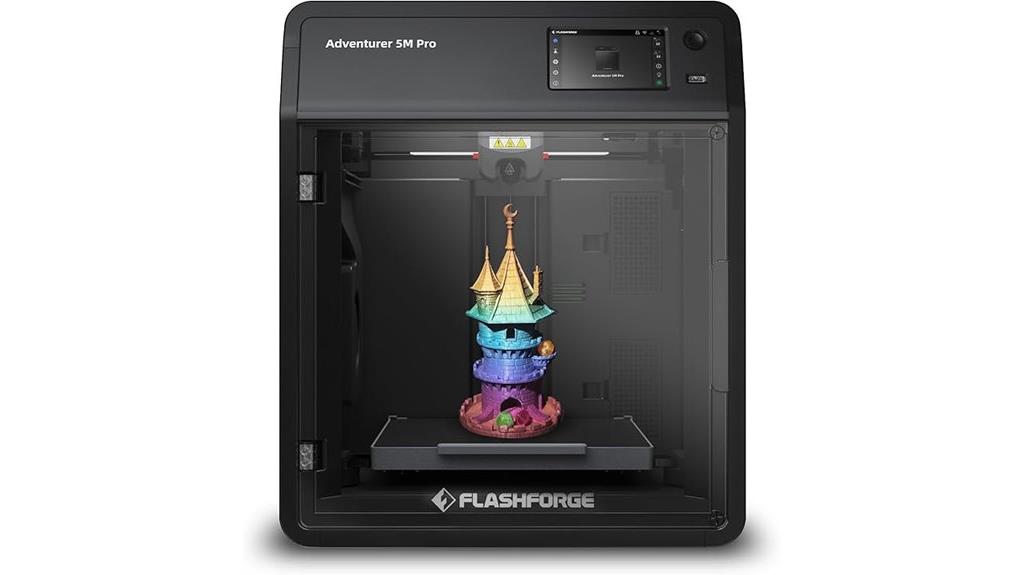
The FLASHFORGE Adventurer 5M Pro 3D Printer is designed for users who prioritize speed and efficiency without sacrificing print quality. With a Core XY structure and all-metal frame, it delivers stability at high speeds, reaching up to 600mm/s and 20,000mm/s² acceleration. It features smart automatic bed leveling and a dual-sided PEI platform for easy model removal. Nozzle options range from 0.25mm to 0.8mm, balancing speed and detail. Setup takes just 10 minutes, and the Flash Maker app allows remote monitoring. Compatible with multiple materials, including composites, it’s ideal for functional prototypes and durable components. Rated 3.9/5 stars, it’s a top choice for pros and hobbyists alike.
Best For: Best For: professionals and enthusiasts who need high-speed, high-quality 3D printing without compromising on material flexibility.
Pros:
- High-speed printing up to 600mm/s and 20,000mm/s² acceleration for efficient production.
- Smart automatic bed leveling and dual-sided PEI platform for easy setup and model removal.
- Compatible with multiple materials, including tough composites like PLA-CF and PETG-CF.
Cons:
- Noisy operation due to high-speed movements.
- Relatively compact build volume, which may limit large-scale printing projects.
- Slightly higher price point compared to entry-level 3D printers.
https://www.amazon.com/dp/B0CH4RG161
Bambu Lab A1 Mini 3D Printer, Multi-Color 3D Printing
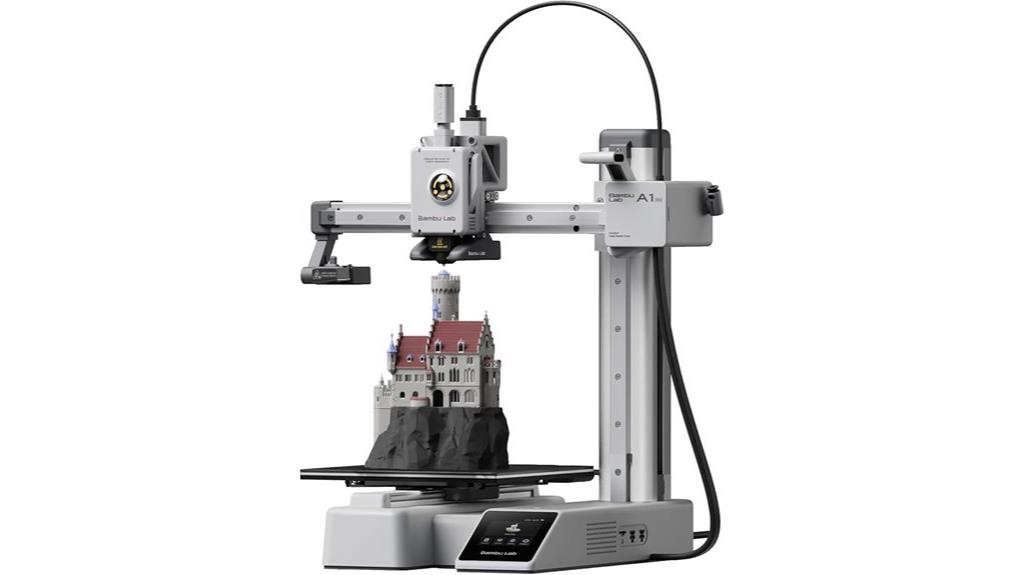
Perfect for hobbyists and professionals seeking vibrant, multi-color prints without the hassle, the Bambu Lab A1 Mini 3D Printer stands out with its AMS Lite support, enabling efficient multi-color printing. It delivers high-speed and precise prints with 10,000 mm/s² acceleration and active flow rate compensation. Setup takes just 20 minutes, thanks to its pre-assembled design and user-friendly touchscreen. The 1-Clip quick swap nozzle simplifies maintenance, while the Bambu Handy app offers guided calibration and real-time monitoring. Quiet operation at ≤48 dB and Wi-Fi connectivity make it a convenient choice. Some users praise its speed and quality, though a few report extruder jams and customer support issues.
Best For: Hobbyists and professionals seeking vibrant, multi-color prints without the hassle.
Pros:
- High-speed printing with consistent precision and 10,000 mm/s² acceleration.
- Quick 20-minute setup with a pre-assembled design and user-friendly touchscreen.
- Easy maintenance with 1-Clip quick swap nozzle and guided app support.
Cons:
- Some users report issues with extruder jamming during printing.
- Poor customer support experiences mentioned in reviews.
- Multi-color printing requires AMS Lite, which may not be ideal for all users.
https://www.amazon.com/dp/B0CRYJBKQQ
Anycubic Kobra S1 3D Printer
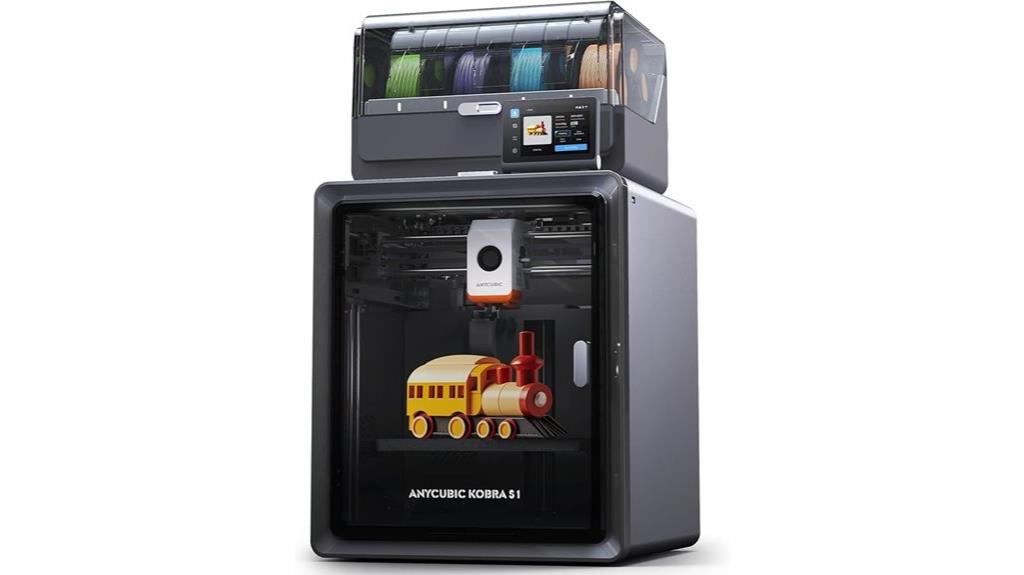
Engineered for creatives and hobbyists seeking vibrant, multi-color prints, the Anycubic Kobra S1 3D Printer excels with its 4-color printing capability and impressive max printing speed of 600mm/s. It features a dual PTC heating module, 360° hot air circulation, and Anycubic Kobra OS with flow compensation for smooth surfaces. The printer is plug-and-play ready and includes sealed filament storage. While users praise its ease of setup and color accuracy, some report issues like error codes and assembly challenges. Weighing 56.1 pounds, it’s compact at 20x20x25 inches. Remote control via the Anycubic App adds convenience, but verify correct voltage settings to avoid issues.
Best For: Best for creatives and hobbyists seeking vibrant multi-color prints with high-speed performance and ease of setup.
Pros:
- 4-color printing capability for vibrant and detailed prints.
- High max printing speed of 600mm/s for efficient workflow.
- Easy setup and plug-and-play functionality for quick starting.
Cons:
- Some users report issues with error codes and firmware problems.
- Problems with support material adhesion affecting print quality.
- Assembly challenges and required technical troubleshooting.
https://www.amazon.com/dp/B0DQPB38VD
Creality K2 Plus Combo 3D Printer, Build Volume 350 * 350 * 350mm
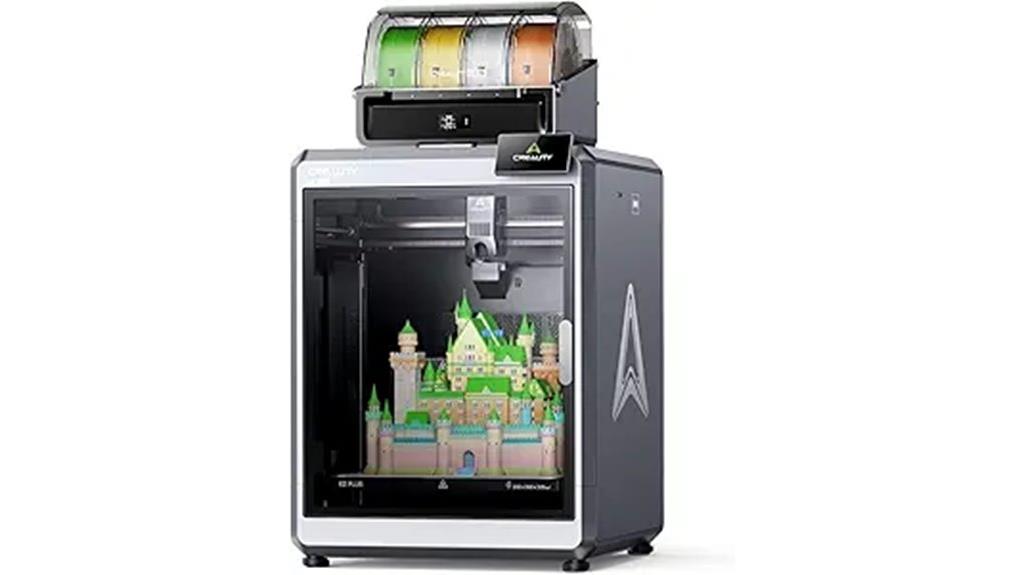
A standout choice for hobbyists and professionals seeking large-format printing, the Creality K2 Plus Combo 3D Printer offers a spacious 350x350x350mm build volume, making it ideal for complex or sizable projects. It supports multi-color printing with up to 4 CFS units and materials like PLA, ABS, and PETG. Features include dual AI cameras for monitoring, an auto-leveling system, and a direct drive extruder with automated filament cutting. While it’s praised for efficient multi-material printing and setup, some users report mechanical issues and customer service problems. Its 600mm/s print speed and high-temp nozzle make it versatile, though reliability concerns remain.
Best For: Hobbyists and professionals seeking large-format printing capabilities for complex or sizable projects, with support for multi-color and diverse material options.
Pros:
- Supports up to 4 CFS units for multi-color printing and versatile material compatibility.
- Auto-leveling system with dual motorized Z-axes and strain gauge compensation ensures precise calibration.
- Direct Drive Extruder with automated run-out and sensor filament cutter for efficient and convenient printing.
Cons:
- Reports of frequent mechanical issues and extruder clogs affecting reliability.
- Poor customer service experiences cited by some users.
- Large build volume may not be ideal for users with limited workspace.
https://www.amazon.com/dp/B0F5HJMMT9
Anycubic 3D Printer Kobra S1 Combo
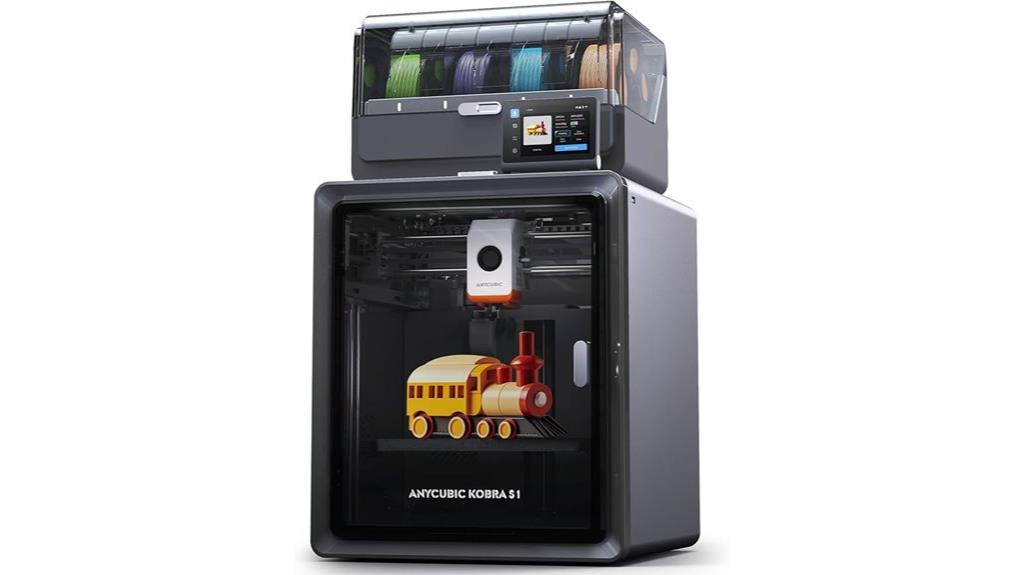
The Anycubic Kobra S1 Combo stands out as a versatile 3D printer, ideal for those seeking vibrant multi-color prints and high-speed performance, with a max speed of 600mm/s and 20,000 mm/s² acceleration. It features a dual PTC heating module, 360° air circulation, and Anycubic Kobra OS for smooth finishes. The printer is ready to use out of the box, supporting remote control via the Anycubic App. Users praise its vibrant prints and ease of setup, though some note issues like error codes and adhesion problems. Tips include checking voltage settings, updating firmware, and handling support material carefully.
Best For: Enthusiasts and professionals seeking high-speed, multi-color 3D printing with vibrant results.
Pros:
- High-speed printing with a max speed of 600mm/s and 20,000 mm/s² acceleration.
- Vibrant multi-color printing capability with smooth surface finishes.
- Easy setup and operation, with remote control via the Anycubic App.
Cons:
- Users report occasional error codes and poor support material adhesion.
- Some assembly challenges and potential black screen issues if voltage settings are incorrect.
- Non-flat magnetic steel build platform may require additional adjustments.
https://www.amazon.com/dp/B0DQPB38VD
Creality K1 Max 3D Printer, High-Speed with Auto Leveling, Dual Cooling, and Large Printing Size (600mm/s, 11.81×11.81×11.81in)
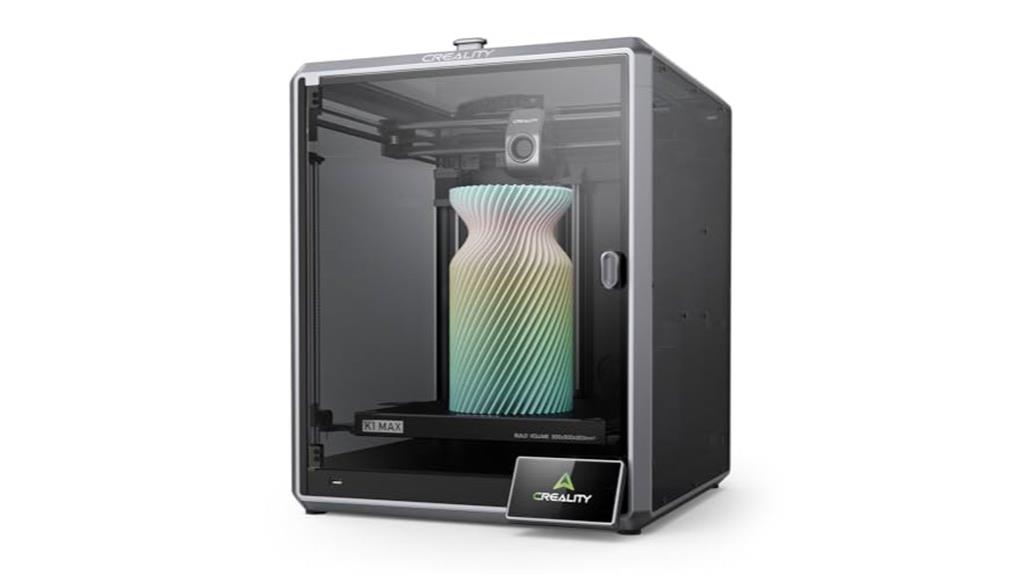
For those prioritizing speed without sacrificing quality, the Creality K1 Max 3D Printer stands out as a top choice, offering a maximum print speed of 600mm/s and a large build volume of 300×300×300mm. Its dual cooling system guarantees precise temperature control, while the titanium alloy hotend and ceramic heater deliver reliable filament melting. The printer’s AI-powered features, like a LiDAR scanner and monitoring camera, enhance accuracy and troubleshooting. Fully assembled and ready to use, it’s a solid option for experienced users, though the setup may require patience due to unclear instructions. 24/7 support is available, but some users report mixed experiences.
Best For: Experienced hobbyists and professionals seeking high-speed, large-format 3D printing with advanced features like AI monitoring and dual cooling.
Pros:
- High maximum print speed of 600mm/s with rapid acceleration for efficient printing.
- Large build volume of 300×300×300mm for creating sizable projects.
- Advanced AI features, including LiDAR scanning and a monitoring camera for precision and error detection.
Cons:
- Challenging setup process due to unclear instructions.
- Mixed customer support experiences, potentially affecting troubleshooting reliability.
- Large printer size may require significant workspace.
https://www.amazon.com/dp/B0F59YR8CP
X-Maker Joy 3D Printer for Kids with 8 PLA Filaments & STEM Toy Library
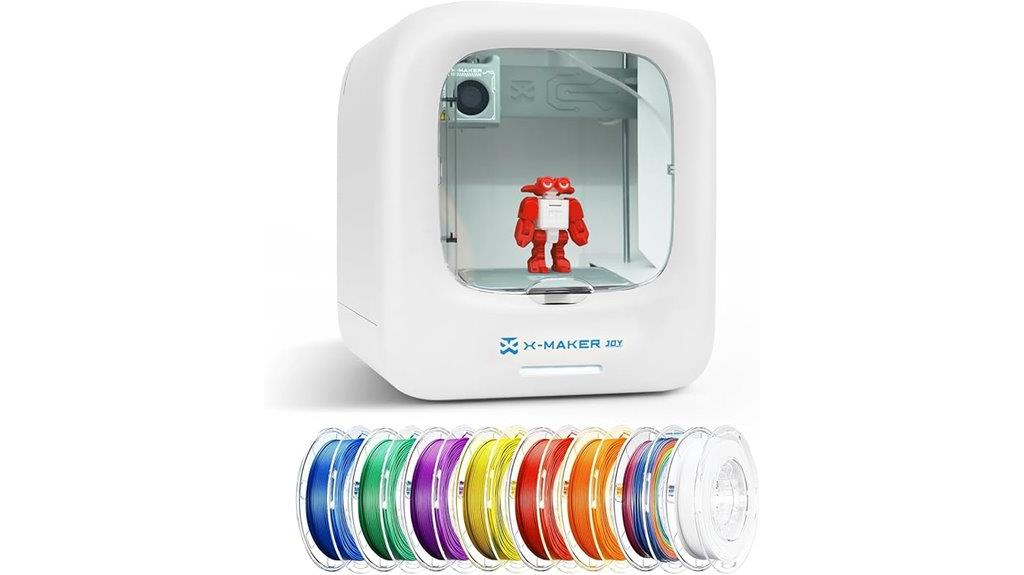
Designed for kids and beginners, the X-Maker Joy 3D Printer is an excellent choice for fostering creativity and STEM learning with its included 8 PLA filaments and extensive toy library. It features Wi-Fi and app control with voice commands, a built-in camera for real-time monitoring, and a quick-release nozzle for easy filament changes. The printer is safe and user-friendly, with a fully enclosed structure and plug-and-play platform. You’ll also get access to over 1,500 digital designs, weekly updates, and DIY personalization options. Parents and kids alike praise its ease of use and creative potential, though some note it’s best for smaller prints.
Best For: Kids, beginners, and families interested in STEM education and creative 3D printing projects.
Pros:
- Built-in camera and real-time monitoring for easy tracking of prints.
- INCLUDED 8 PLA filaments and access to 1,500+ digital designs with weekly updates.
- Fully enclosed, safe, and beginner-friendly design with plug-and-play setup.
Cons:
- Some users report issues with handling longer print jobs.
- Filament changes can be cumbersome due to the enclosed structure.
- Limited to smaller prints, as noted by some customers.
https://www.amazon.com/dp/B0D6FVYSC7
FLASHFORGE Adventurer 5M 3D Printer
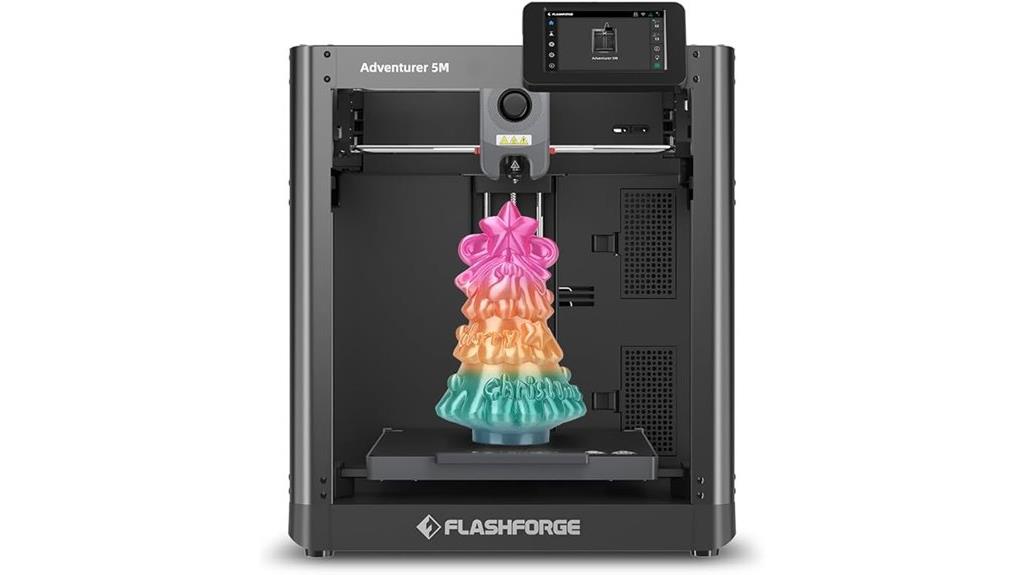
FLASHFORGE Adventurer 5M stands out as a top choice for 3D printing enthusiasts seeking fast, reliable prints with minimal setup hassle. It features a 220x220x220mm print size, auto leveling, a dual-sided PEI coating plate, and a direct extruder. The quick-detachable 280°C nozzle enhances versatility. Reaching 600mm/s, it supports PLA, PETG, and TPU. Users praise its fast printing and durability, though some note noise and bed leveling issues. A robust build quality makes it ideal for enthusiasts, balancing speed and reliability.
Best For: Hobbyists, educators, and small businesses seeking a reliable, fast, and versatile 3D printer with minimal setup hassle.
Pros:
- Fast printing speeds up to 600mm/s with reliable performance.
- Easy setup and auto leveling for convenience.
- Robust build quality and compatibility with multiple filaments, including PLA, PETG, and TPU.
Cons:
- Noise from the cooling fan can be disruptive.
- Some users experience challenges with bed leveling despite auto leveling feature.
- PTFE tube length and filament sensor default off may require adjustments.
https://www.amazon.com/dp/B0CHJGFVSL
Fully Assembled Mini 3D Printer for Kids and Beginners
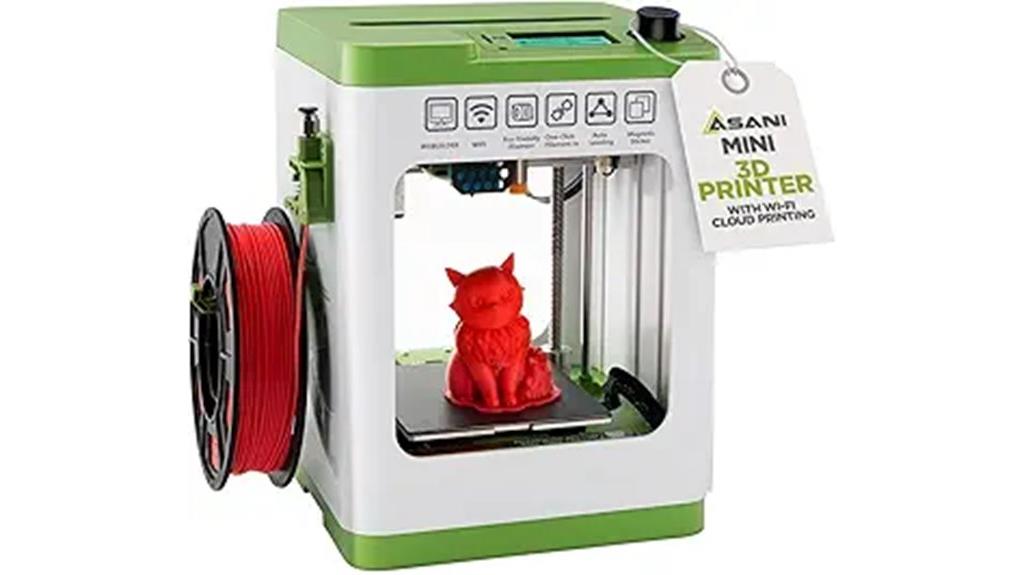
This fully assembled mini 3D printer is an excellent choice for kids and beginners, offering a plug-and-play experience with its pre-installed software, 10M PLA filament, and included accessories. Compact and lightweight (8.3” x 8.3” x 11.4”) with WiFi capability, it’s easy to set up and use. Features include auto-leveling, dual z-axis rail, 2.4” LCD screen, and a magnetic build plate. Compatible with 1.75mm PLA, PLA Pro, and TPU filaments, it comes with pre-installed models and software. Priced affordably with a 4.5-star rating, it’s a great starter for learning the basics of 3D printing.
Best For: Kids and beginners looking for an easy-to-use, plug-and-play 3D printing experience.
Pros:
- Fully assembled and pre-installed software for quick setup.
- Compact, lightweight, and WiFi-enabled for easy operation.
- Includes auto-leveling, pre-installed models, and essential accessories.
Cons:
- Small build volume (100mm x 120mm x 100mm) limits project size.
- Beginners might outgrow its capabilities as they gain experience.
- Comes with only 10M of PLA filament, which may require quick replenishment.
https://www.amazon.com/dp/B0C9PBKFYH
Upgraded Tina2S 3D Printer by HEPHI3D – WiFi Cloud Printing, Auto Bed Leveling, Fully Assembled Mini 3D Printer for Beginners
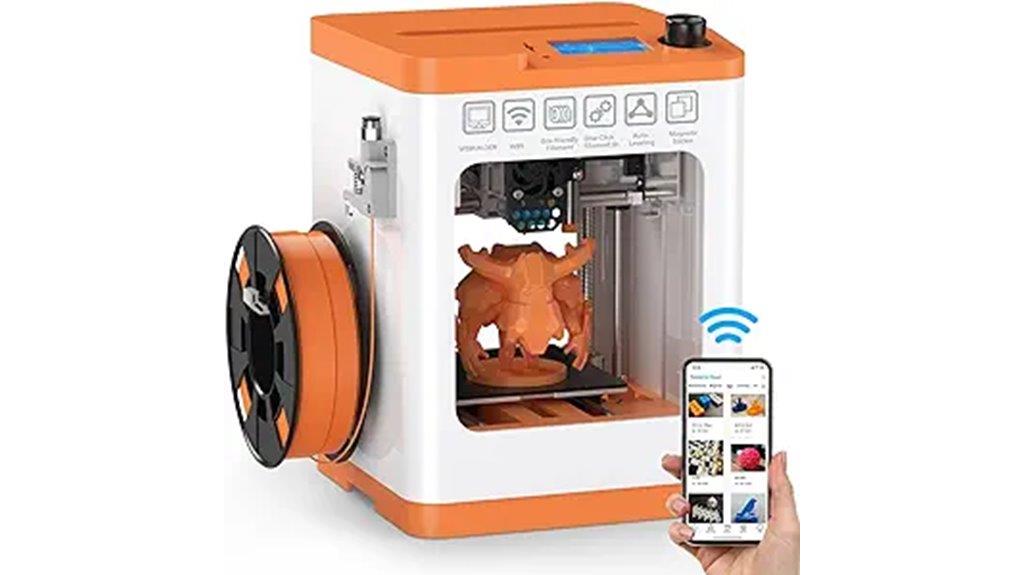
The Upgraded Tina2S 3D Printer by HEPHI3D stands out as an excellent choice for beginners, thanks to its user-friendly design and robust features. This compact, fully assembled printer offers WiFi cloud printing via Poloprint and auto bed leveling for hassle-free setup. It operates quietly at 40~50dB and prints fast at 200mm/s. The heated PEI spring steel magnetic platform and Teflon PTFE copper hose guarantee smooth, high-quality prints. With a 30-day return policy and 12-month warranty, it’s a reliable option. While users praise its ease of use and portability, some note issues with filament jamming and durability over time.
Best For: Beginners, hobbyists, or educators seeking a user-friendly, compact, and versatile 3D printing solution.
Pros:
- Fully assembled and easy to set up, ideal for beginners.
- Features WiFi cloud printing and auto bed leveling for convenience.
- Quiet operation (40~50dB) and fast print speed (200mm/s).
Cons:
- Some users report issues with filament jamming and nozzle clogging.
- Questions about long-term durability.
- Compact build limits print size for larger projects.
https://www.amazon.com/dp/B0CMHM6XQG
Creality K2 Plus Combo 3D Printer, Multi-Color Printing with Auto Leveling & Dual Camera
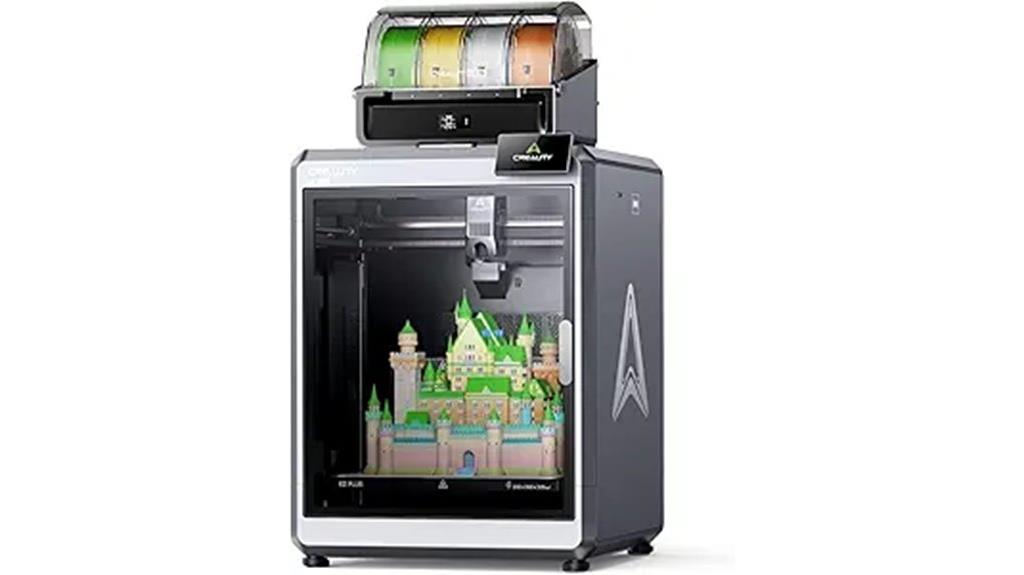
Multi-color printing meets precision engineering with the Creality K2 Plus Combo, designed for enthusiasts and professionals seeking vibrant, complex prints. Boasting up to 4 CFS units for 16-color capability, this printer delivers intricate designs with a step-servo motor system that accelerates up to 30,000mm/s². Features include dual AI cameras for real-time monitoring, auto-leveling with dual Z-axes, and a heated chamber. While users praise its efficiency and value, some report issues like damaged units and extruder clogs. Weighing 116.2 pounds, it’s a robust option for those seeking advanced multi-material printing. Its 350x350x350mm build volume supports PLA, ABS, PETG, and more.
Best For: Enthusiasts and professionals seeking advanced multi-material and multi-color 3D printing with high precision and monitoring capabilities.
Pros:
- High-speed printing with up to 600mm/s and 30,000mm/s² acceleration for efficient workflows.
- Advanced multi-color printing with support for up to 4 CFS units (16 colors) for intricate designs.
- Dual AI cameras and auto-leveling system ensure real-time monitoring and precise calibration.
Cons:
- Reports of damaged units and frequent mechanical issues affecting reliability.
- Extruder clogs and filament recognition problems can disrupt printing processes.
- Poor customer service experiences noted by some users.
https://www.amazon.com/dp/B0F5HJMMT9
Anycubic Kobra S1 Combo 3D Printer with High Speed and Built-in Camera
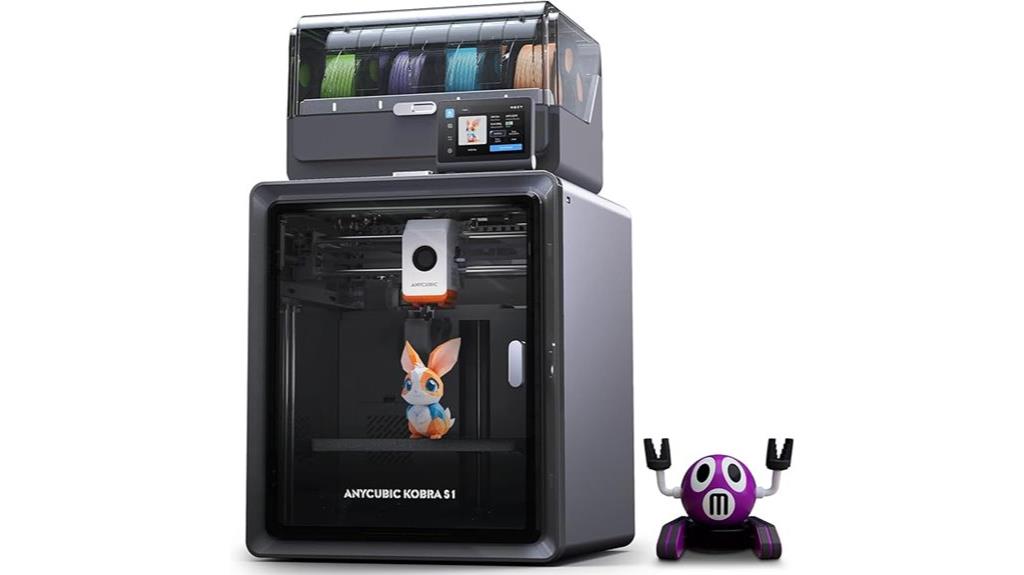
Ideal for 3D printing enthusiasts and professionals seeking high-speed performance, the Anycubic Kobra S1 Combo 3D Printer stands out with its built-in camera and 600mm/s printing capability. Designed for efficiency, it features a CoreXY structure, 320℃ full metal hotend, and quiet mode at 44dB. The included Anycubic ACE Pro supports up to 8-color printing with dual PTC heating and anti-tangling technology. Monitor prints effortlessly via the built-in camera and Anycobic App. While praised for its speed and print quality, some users note issues with filament jamming and ACE Pro reliability. Perfect for multi-color projects, it’s a versatile option for creators.
Best For: 3D printing enthusiasts and professionals seeking high-speed, multi-color printing capabilities.
Pros:
- High-speed printing up to 600mm/s.
- Built-in camera for remote monitoring via the Anycobic App.
- Supports up to 8-color printing with the Anycubic ACE Pro.
Cons:
- Issues with ACE Pro reliability and filament jamming.
- Some users report problems with product reliability.
- Mixed experiences with technical support.
https://www.amazon.com/dp/B0DBDT2ZZJ
Factors to Consider When Choosing: 3D Printers
When choosing a 3D printer, you’ll need to evaluate several key factors to find the best fit for your needs. These include print speed and precision, build volume and capacity, material compatibility, setup and usability, and noise and safety. Evaluating these aspects makes certain the printer aligns with your projects, whether you’re prototyping, producing large-scale objects, or working in a home environment.
Print Speed and Precision
The balance between print speed and precision is an important consideration when choosing a 3D printer. Print speed, measured in millimeters per second (mm/s), affects how quickly a model is produced, but higher speeds can compromise detail quality. Print resolution, determined by layer thickness and nozzle size, impacts detail accuracy—smaller nozzles offer finer details but require more time. Acceleration and jerk settings influence speed and surface quality; higher values enable faster prints but may cause vibrations, affecting precision. Direct drive extruders are better for flexible materials, offering precision, while Bowden systems prioritize speed and material compatibility. Control systems, like stepper motor drivers and belt specs, maintain accuracy at higher speeds, ensuring stability and detail retention. Balancing these factors is key to achieving your printing goals.
Build Volume and Capacity
Build volume determines the size of objects your printer can handle, ranging from small models like 100mm x 120mm x 100mm to larger ones up to 350x350x350mm for bigger projects. A larger build volume gives you more flexibility, but consider your workspace and how often you’ll print large objects. Compact printers are great for small-scale creations, while larger models suit complex or industrial-level tasks. The type of build platform, like dual-sided PEI or magnetic steel plates, impacts how easily you can remove prints and guarantee proper adhesion. Features like auto-leveling simplify setup, letting you maximize your build volume efficiently. Pairing the right extruder type with your printing needs also affects the complexity and size of what you can create, making sure your printer meets your specific demands.
Material Compatibility
When selecting a 3D printer, material compatibility is essential to match your project needs. Look at the types of filaments—like PLA, ABS, or PETG—the printer supports, as compatibility varies. Extruder type and temperature range are key; all-metal extruders handle higher temps, while direct drive extruders work better for flexible filaments. The build plate’s surface, such as PEI or glass, impacts adhesion for different materials. Moisture control features, like dry boxes, are critical for hygroscopic filaments. Finally, check if the printer supports multi-material printing via dual extruders for more complex projects. Guaranteeing your printer can handle the materials you need secures successful prints and versatility in your work.
Setup and Usability
As you consider setup and usability, smart features like automatic bed leveling can make a big difference. Printers with multi-point auto-leveling eliminate the hassle of manual adjustments, saving you time and frustration. Look for models with intuitive interfaces, such as touchscreens or app controls, which simplify navigation and calibration. Some printers even offer guided setup processes or app-based troubleshooting, making it easier for beginners to get started. Additionally, features like auto-resume after power failures or filament runout sensors can enhance your overall experience. A printer that’s easy to set up and use promotes a smoother workflow, helping you focus on creating rather than problem-solving. Choosing a model with these features can dramatically improve your 3D printing journey, especially if you’re new to the craft.
Noise and Safety
Noise can be a significant consideration when selecting a 3D printer, especially for home or office use. Printers with noise levels between 40-50 dB are considered quiet and suitable for shared spaces. Look for models with belt-driven systems and vibration dampening to minimize operational noise.
Safety is another critical factor. Enclosed printers reduce risks by preventing direct contact with hot components and often include features like auto-shutoff for emergencies. Temperature control systems guarantee safe operation by maintaining ideal heat levels and preventing overheating. Additionally, automatic safety features such as thermal protection and filament run-out sensors can prevent accidents. Prioritizing these aspects will help you choose a printer that is both quiet and safe for your environment.
Frequently Asked Questions
What Is the Typical Price Range of These 3D Printers?
The typical price range for 3D printers varies widely, depending on features, size, and intended use. Entry-level models for hobbyists often cost between $200 and $1,000, offering basic functions. Mid-range printers, suitable for enthusiasts, typically range from $1,000 to $3,000, providing better quality and more versatility. High-end models, designed for professionals or industrial use, can start at $3,000 and go upwards, depending on advanced features like multi-material printing or high precision.
Can These Printers Be Used for Industrial-Scale Production?
You might be surprised to learn that 3D printers are now revolutionizing warehouses as much as they’re transforming home workshops. High-end models, like those featured in the best of 2025, can indeed handle industrial-scale production, churning out large batches and complex parts with precision. They often support continuous operation and advanced materials, making them ideal for manufacturing. However, don’t assume all printers are equal—only industrial-grade machines are built for heavy-duty, while consumer and entry-level printers are better suited for small-scale projects.
What Maintenance Is Required to Keep the Printers in Good Condition?
You’ll need to clean the print bed and extruder regularly to prevent dust and residue buildup. Check and tighten belts and pulleys to verify proper alignment. Lubricate moving parts like gears and rods to maintain smooth operation. Replace worn nozzles and belts as needed. Keep the printer’s firmware updated for peak performance. Monitor temperature controls and verify proper ventilation to avoid overheating. Regularly inspect and replace worn-out components to maintain print quality and extend the printer’s lifespan.
Are These Printers Compatible With Third-Party Filament Brands?
Flexibility and freedom fuel your 3D printing projects. Most printers support third-party filaments, but you must check compatibility. Whether it’s PLA, ABS, or PETG, ensuring the filament type aligns with your printer’s settings is essential. Some printers may require adjusting nozzle temperatures or retraction settings for best performance with non-OEM filaments. Always review the printer’s specs and the filament’s properties to guarantee smooth, successful prints.
Do the Printers Come With a Warranty or Support Service?
When you purchase a 3D printer, you’ll find that most brands offer some form of warranty or support service. These warranties typically cover parts and labor for a specific period, often ranging from six months to several years. Many manufacturers also provide customer support through online resources, live chat, or phone assistance. Some brands even offer extended warranty options or premium support plans for an additional fee, giving you peace of mind for repairs and troubleshooting.
Conclusion
You’re not just shopping for a 3D printer—you’re stepping into the shoes of a modern-day Leonardo da Vinci, crafting the future one layer at a time. With these top-tier machines, the boundaries of creativity blur, and innovation knows no limits. Whether you’re a pro or a newbie, these printers level the playing field, offering precision, speed, and versatility. Plunge in, and let your imagination take shape—because in 2025, the possibilities are endless, and the world is your canvas.

Maria is brilliant when it comes to creating beautiful and functional spaces. Maria has an exceptional ability to understand your needs and desires, translating them into tailored solutions that reflect your personality and lifestyle. Whether you’re seeking advice on home decor, looking to upgrade your interior, or seeking inspiration to enhance your quality of life through design, Maria can help you achieve your goals. With Maria by your side, your vision for the perfect home is within reach.
